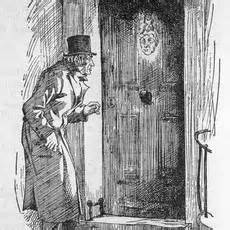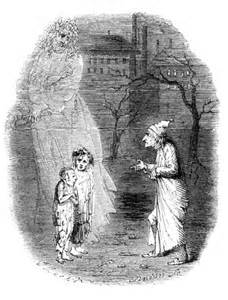A Christmas Carol
A Christmas Carol is the most well-known work by one of England's most well-known authors, Charles Dickens. He wrote many books before and after, but the transformation of Ebenezer Scrooge from a miser to a philanthropist in the space of one night is his most famous.
The story is set at Christmastime, and two visitors to Scrooge's office in the early moments of the story are collecting for charity. Their repartee with Scrooge over what to do with other people's money contains some of the most memorable lines in the story: "Are there no prisons? And the union workhouses? Are they still in operation" and, of course, "Bah. Humbug!" At home, Scrooge is harassed by spirits showing him his old life, the lives of other people at present, and the possible future lives of not only his clerk's family but also Scrooge himself. And while Scrooge is being visited in his non-sleep (or his dreams) by the Ghosts of Past, Present, and Yet to come, Bob Cratchit is ensconced in his meager family home with his large family, including his disabled son, (Tiny) Tim. The book is divided into five chapters, or staves, as Dickens styled them. The opening actions, in Scrooge's office, and the encounter with Marley's ghost, occur in Stave I. Staves II, III, and IV are the visits of the spirits. Stave II is a look into Scrooge's past, when he was a happy boy who lost a girl, Belle, because of his devotion not to her but to wealth. Belle has this to say, "I have seen your nobler aspirations fall off, one by one, until the master passion, Gain, engrosses you.”
Stave IV is a glimpse of a future, when a certain man is dead and his belongings are being fought over, when Tiny Tim has not survived his debilitating condition. Scrooge, in desperation, appeals for actions to take in order to avoid the twin views of despair: "Men's courses will foreshadow certain ends, to which, if persevered in, they must lead … But if the courses be departed from, the ends will change. Say it is thus with what you show me." Scrooge sees enough of a bad thing during the night to convince him to turn over a new leaf. When he awakens (in Stave V) and finds that it is just Christmas morning, he is overcome with generosity and gives more than his fair share not only to the Cratchit family but also to his own, in the form of gifts to his nephew of, primarily, himself and his new presence. He didn't worry what other people thought of his transformation, either: "His own heart laughed: and that was quite enough for him." Scrooge is thus reformed, from a miser into a giver, and the last lines of the story say how Scrooge became a benefactor to Tiny Tim, helping cure the condition that had crippled him from a very young age. Many of the elements of the horrors that Ebenezer Scrooge sees at the behest of the four spirits (Jacob Marley and the Ghosts of Past, Present, and Yet to Come) were elements of the reality of the English landscape, both overall and in Dickens's personal experience. A poor child, he was sent away to a workhouse to make money to pay the family debts. The Industrial Revolution had put a great many people out of work and had furthered a widening gap between rich and poor.
Dickens wrote the book in just six weeks, beginning in September 1843 and finishing just before Christmas. It was a runaway success, pleasing both fans and critics of Dickens. Dickens was not happy with the earnings on his previous book, Martin Chuzzlewit, and so refused the usual lump sum payment for A Christmas Carol. Instead, Dickens assumed the production costs himself and then agreed to a share of the profits. In 1853, Dickens read the entire book in a public performance, on a stage, in an auditorium. Two thousand people were treated to Dickens's full-bore performance, including the employment of different voices and mannerisms for different characters but no costume changes or even props. Dickens continued to do these public performances throughout the next 17 years. (The last performance was just three months before his death, in 1870.) In the years since its first publication, the story of Scrooge has been the basis of plays, movies, operas, musical compositions, and thousands of other fictional stories in many languages all across the planet. Read it online. |
|
Social Studies for Kids
copyright 2002–2024
David White



 The main character in A Christmas Carol is Ebenezer Scrooge, the surviving owner of a once-partnership that owned a moneylending business. The other partner, Jacob Marley, is the first ghost that Scrooge sees. Marley warns Scrooge to avoid forging his own chain of regret, as Marley himself did.
The main character in A Christmas Carol is Ebenezer Scrooge, the surviving owner of a once-partnership that owned a moneylending business. The other partner, Jacob Marley, is the first ghost that Scrooge sees. Marley warns Scrooge to avoid forging his own chain of regret, as Marley himself did.  The present is the focus of Stave III, as Scrooge observes the merriment of the goings-on at the home of his nephew Fezziwig, the sparseness of the home of Bob Cratchit, and the twin symbols (represented as a young boy and a young girl) of ignorance and want. Despite the relatively little that the Cratchit family has and the terrible physical condition that Tiny Tim is in, the little boy has this particular wish for his family at Christmastime: "God bless us, everyone."
The present is the focus of Stave III, as Scrooge observes the merriment of the goings-on at the home of his nephew Fezziwig, the sparseness of the home of Bob Cratchit, and the twin symbols (represented as a young boy and a young girl) of ignorance and want. Despite the relatively little that the Cratchit family has and the terrible physical condition that Tiny Tim is in, the little boy has this particular wish for his family at Christmastime: "God bless us, everyone."  Dickens took part of his inspiration from his own written work. His first novel, The Pickwick Papers, contained the story of a gravedigger named Gabriel Grubb, who is pointed in his determination not to be merry at Christmas time. In the story, "The Story of the Goblins Who Stole a Sexton," is taken away by goblins who show him the past and a possible future. Based on these experiences, Grubb changes his ways.
Dickens took part of his inspiration from his own written work. His first novel, The Pickwick Papers, contained the story of a gravedigger named Gabriel Grubb, who is pointed in his determination not to be merry at Christmas time. In the story, "The Story of the Goblins Who Stole a Sexton," is taken away by goblins who show him the past and a possible future. Based on these experiences, Grubb changes his ways. 
